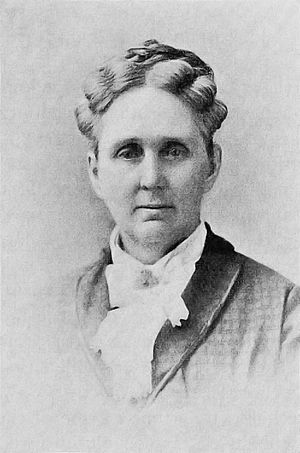Anna Morris Holstein facts for kids
Quick facts for kids
Anna Morris Holstein
|
|
|---|---|
 |
|
| Born | Anna Morris Ellis April 9, 1824 Muncy, Pennsylvania, U.S. |
| Died | December 31, 1900 (aged 76) near Bridgeport, Pennsylvania, U.S. |
| Pen name | "Mrs. H." |
| Occupation | organizational founder, civil war nurse, author |
| Spouse |
William Hayman Holstein
(m. 1848; died 1894) |
| Relatives | Samuel Morris (great-grandfather) |
Anna Morris Holstein (born Ellis, also known as "Mrs. H.") was an important American woman. She was born on April 9, 1824, and passed away on December 31, 1900. During the American Civil War, she worked as a nurse in hospitals. After the famous Battle of Gettysburg, she was in charge of a hospital that cared for 3,000 wounded soldiers.
Anna Holstein also helped save important historical places. She was a founder of the Centennial and Memorial Association of Valley Forge. This group helped buy and fix up George Washington's headquarters at Valley Forge National Historical Park. This made the historic site open for everyone to visit. She was also a leader in the Valley Forge Chapter of the Daughters of the American Revolution (D.A.R.).
Contents
Early Life and Family History
Anna Morris Ellis was born in Muncy, Pennsylvania, on April 9, 1824. Her parents were William C. and Rebecca (Morris) Ellis.
Her family had a history of helping the United States. Her great-grandfather, Captain Samuel Morris, was a captain in the first city troop of Philadelphia. This troop protected George Washington during the American Revolutionary War. He was with Washington at the battles of Trenton and Princeton. He was even known as a leader of the "fighting Quakers." Her grandfather, Richard Wells, helped supply the U.S. fleet during the Revolution.
Helping During the Civil War
On September 26, 1848, Anna married William Hayman Holstein. His family also played a role in the American Revolution. Anna and William often worked together on important projects.
When the Civil War began, William joined the 17th Pennsylvania militia. Soon after, in May 1861, Anna and William started working in army hospitals. They continued this work until the war ended. Anna was with the Army of the Potomac during the winter of 1862-63. She traveled with the army's hospital train as they moved towards Pennsylvania.
After the Battle of Gettysburg, Anna became the main manager (matron-in-chief) at Camp Letterman. This was a large hospital in Gettysburg that cared for 3,000 wounded soldiers. She had also helped at many other places like Sharpsburg and Annapolis. At Annapolis, she cared for soldiers who had been held in prison camps.
When there were breaks in army fighting, Anna worked with the Sanitary Commission. This group helped support soldiers. She met with thousands of women across Pennsylvania. She taught them how they could help by sewing and doing other tasks for the soldiers.
Anna and her husband were even close to President Abraham Lincoln when he gave his famous speech at the dedication of the Gettysburg National Cemetery.
Author and Historian
Anna wrote about her experiences during the Civil War. She published a book called Three years in field hospitals of the Army of the Potomac in 1867. She also wrote The Holstein Family History and articles for magazines. One article was "Women of Montgomery County in War Time." She was a member of the Historical Society of Montgomery County, Pennsylvania.
Anna Holstein was very dedicated to preserving history. She and her husband were among the first people to help save George Washington's home at Mount Vernon.
She also played a huge role in saving Valley Forge. She helped create the Valley Forge Centennial and Memorial Association. This group was started in 1878. Anna was the leader (regent) of this group until she passed away. She also helped start the Valley Forge Chapter of the D.A.R. She was its first regent.
Valley Forge was a very important place during the American Revolution. It was where Washington's army spent a very difficult winter. Anna worked hard to save Washington's headquarters there. She wanted to make sure people remembered the importance of Valley Forge.
The Centennial and Memorial Association of Valley Forge worked to buy and restore Washington's headquarters. They held a big event on June 19, 1878. This event celebrated 100 years since the army left Valley Forge. The money raised helped them buy Washington's headquarters. They also bought more land and restored the home to how it looked in 1777-1778. Because of these efforts, Valley Forge became the first State Park in Pennsylvania in 1893.
Later, Anna Holstein also served as a manager for the Pennsylvania Building at the World's Fair.
Death and Legacy
Anna Holstein passed away at her home near Bridgeport, Pennsylvania, on December 31, 1900.
The Valley Forge Chapter, D.A.R., gave a special Prayer Desk to the Washington Memorial Chapel. This gift was in memory of Anna Holstein, who was their first leader and founder. It was dedicated on June 19, 1916. The desk has special designs and symbols carved into it.
Selected Works
- Three years in field hospitals of the Army of the Potomac (1867)
- Swedish Holsteins in America from 1644 to 1892 (1892)
- Valley Forge : Winter of 177-78 The Darkest Period of the Revolution. Washington Headquarters Centennial and Memorial Association Patriotic Order Sons of America. (published after her death in 1903)
Images for kids




